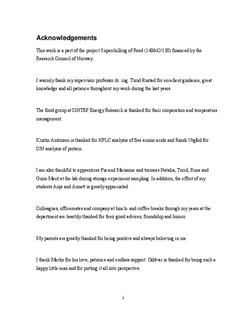| dc.contributor.advisor | Rustad, Turid | nb_NO |
| dc.contributor.author | Duun, Anne Sissel | nb_NO |
| dc.date.accessioned | 2014-12-19T13:10:44Z | |
| dc.date.available | 2014-12-19T13:10:44Z | |
| dc.date.created | 2008-05-29 | nb_NO |
| dc.date.issued | 2008 | nb_NO |
| dc.identifier | 124388 | nb_NO |
| dc.identifier.isbn | 978-82-471-9113-2 | nb_NO |
| dc.identifier.uri | http://hdl.handle.net/11250/244472 | |
| dc.description.abstract | Superchilling is a method that can be used to prolong the shelf life of foods by partial freezing. Knowledge of the effects of this method on both the shelf life and quality of foods is important in order to find optimal processing and storage conditions and is of great importance both for the industry and for the consumers. Different raw materials of muscle foods were studied with the purpose of creating a basis for further improvements of both the process and the storage conditions. Products from the commercially important species pork (both roasts and rib steaks), Atlantic salmon (both vacuum packed and wrapped fillets) and Atlantic cod (vacuum packed fillets) were chosen to represent different muscle foods.
Based on both sensory and microbial evaluations, the superchilled storage improved shelf life of pork roasts from 2 to 16 weeks, and shelf life might even be further prolonged if temperature is kept more constant. The H2S-producing bacteria in superchilled cod fillets did not exceed the limit of consumption during the whole storage period of six weeks, while the microbial shelf life of the ice chilled fillets was estimated to be 8 days after processing.
Quality changes have been studied with focus on biochemical and physiochemical properties. One of the major goals in meat and fish processing is the ability to retain water and it was observed that drip loss was lower in superchilled samples compared to traditionally chilled samples in all species studied. However, the subsequent liquid loss was higher both in pork roasts and in cod fillets.
The extractability of protein was used as a tool to monitor protein denaturation. It was found that myofibrillar proteins denatured more easily during superchilled than during traditionally chilled storage both in salmon and in cod fillets. This was confirmed by electrophoresis in salmon. The amount of free amino acids were higher in cod than in salmon and increased more during superchilled storage than during ice chilled storage indicating exoproteolytic activity during storage. Activities of cathepsins B and B + L in salmon fillets were relatively stable during the storage period in all storage groups, demonstrating that these enzymes are not deactivated at the selected storage temperatures and may therefore lead to softening during subsequent chilled storage.
In superchilled samples of all species studied, white spots emerged on the product surface. However, the appearance of spots did not correspond either to higher drip loss or to higher microbial growth on surface of these samples. On the contrary, the total plate counts of superchilled samples were lower than of the other storage groups. This observation also applied to iron agar counts on cod fillets. These findings are interpreted as a strong indication of that the spots most likely were not of microbial origin.
The optimal superchilling process and storage conditions remains to be found for the products studied. From the present results it is reasonable to suggest that optimal storage temperature for the vacuum packed salmon fillets is found between the superchilled temperatures in the present experiments. The quality both of the pork roasts and the cod fillets would probably benefit from a storage temperature slightly closer to 0 °C than those studied. It can also be assumed that the control of the superchilling process is more essential to cod than to salmon and pork. In addition, the properties of the raw material are crucial in order to obtain high quality of products after processing and storage. | nb_NO |
| dc.language | eng | nb_NO |
| dc.publisher | Fakultet for naturvitenskap og teknologi | nb_NO |
| dc.relation.ispartofseries | Doktoravhandlinger ved NTNU, 1503-8181; 2008:151 | nb_NO |
| dc.relation.haspart | Duun, Anne Sissel; Rustad, Turid. Quality of superchilled vacuum packed Atlantic salmon (Salmo salar) fillets stored at −1.4 and −3.6 °C. Food Chemistry. (ISSN 0308-8146). 106(1): 122-131, 2008. | nb_NO |
| dc.relation.haspart | Duun, Anne Sissel; Rustad, Turid. Quality changes during superchilled storage of cod (Gadus morhua) fillets. Food Chemistry. (ISSN 0308-8146). 105(3): 1067-1075, 2007. | nb_NO |
| dc.relation.haspart | Duun, Anne Sissel; Hemmingsen, Anne Karin; Rustad, Turid. Quality of Superchilled Salmon (Salmo salar) Fillets and Rib Steak (M. psoas major) of Pork Stored at Two Temperature Levels. . | nb_NO |
| dc.subject | superchilling | en_GB |
| dc.subject | storage | en_GB |
| dc.subject | salmo salar | en_GB |
| dc.subject | gadus morhua | en_GB |
| dc.subject | pork | en_GB |
| dc.subject | partial freezing | en_GB |
| dc.subject | FORESTRY, AGRICULTURAL SCIENCES and LANDSCAPE PLANNING: Product science: Food science | en_GB |
| dc.title | Superchilling of muscle food: Storage stability and quality aspects of salmon (Salmo salar), cod (Gadus morhua) and pork | nb_NO |
| dc.type | Doctoral thesis | nb_NO |
| dc.source.pagenumber | 134 | nb_NO |
| dc.contributor.department | Norges teknisk-naturvitenskapelige universitet, Fakultet for naturvitenskap og teknologi | nb_NO |
| dc.description.degree | dr.ing. | nb_NO |
| dc.description.degree | dr.ing. | en_GB |
